service MERCEDES-BENZ V-CLASS MPV 2021 User Guide
[x] Cancel search | Manufacturer: MERCEDES-BENZ, Model Year: 2021, Model line: V-CLASS MPV, Model: MERCEDES-BENZ V-CLASS MPV 2021Pages: 337, PDF Size: 9.88 MB
Page 28 of 337
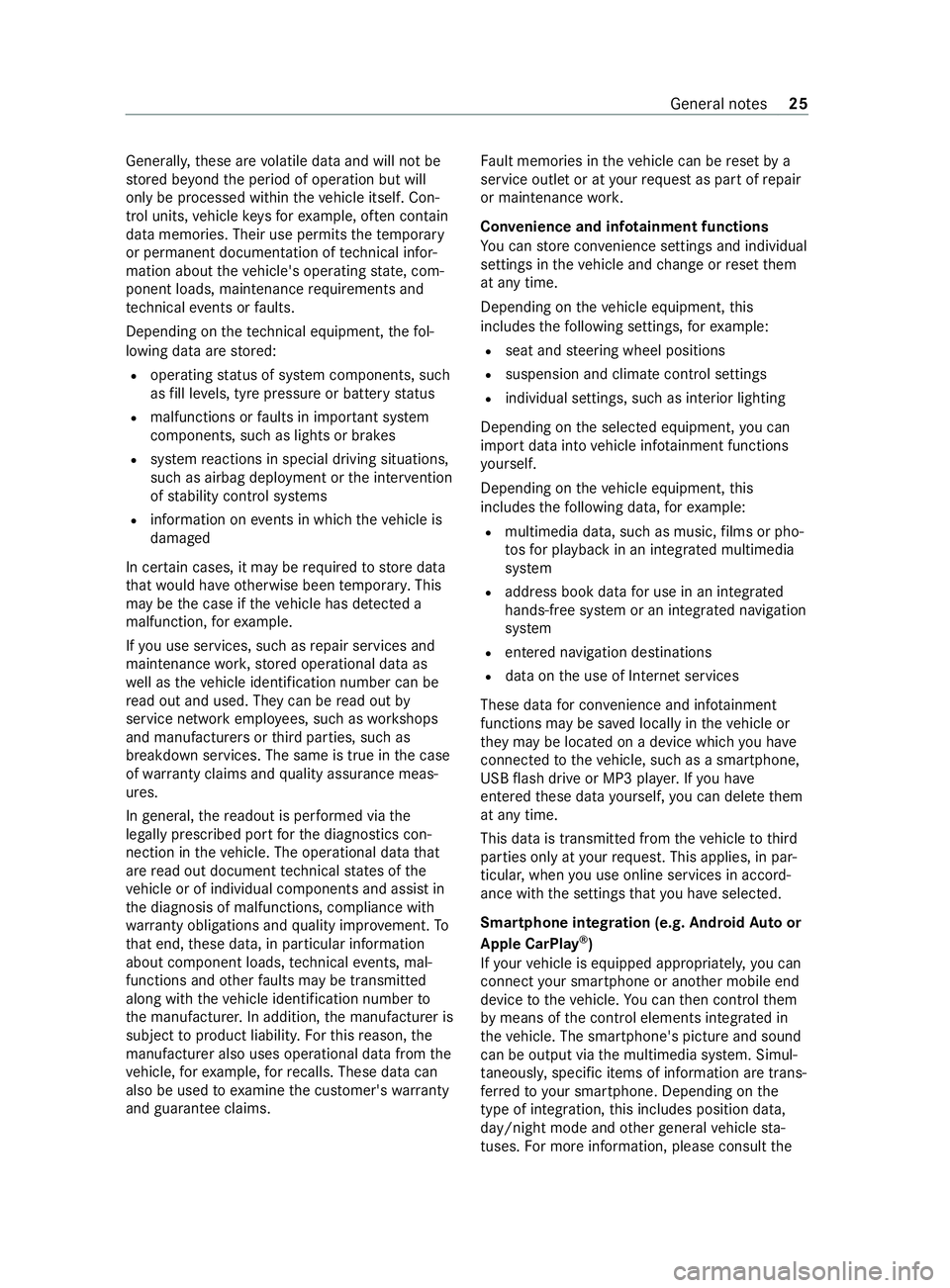
Gene
rally, these are volatile data and will not be
st ored be yond the period of operation but will
only be processed within theve hicle itself. Con‐
trol units, vehicle keys forex ample, of ten contain
da ta memories. Their use permits thete mp orary
or permanent documentation of tech nical infor‐
mation about theve hicle's operating state, com‐
ponent loads, main tenance requirements and
te ch nical events or faults.
Depending on thete ch nical equipment, thefo l‐
lowing data are stored:
R operating status of sy stem components, such
as fill le vels, tyre pressure or battery status
R malfunctions or faults in impor tant sy stem
components, such as lights or brakes
R system reactions in special driving situations,
such as airbag deployment or the inter vention
of stability control sy stems
R information on events in which theve hicle is
damaged
In cer tain cases, it may be requ ired tostore data
th at wo uld ha veotherwise been temp orar y.This
may be the case if theve hicle has de tected a
malfunction, forex ample.
If yo u use services, such as repair services and
maintenance work,st ored operational data as
we ll as theve hicle identification number can be
re ad out and used. They can be read out by
service network emplo yees, such as workshops
and manufacturers or third parties, such as
breakdown services. The same is true in the case
of wa rranty claims and quality assurance meas‐
ures.
In general, there adout is per form ed via the
legally prescribed port forth e diagnostics con‐
nection in theve hicle. The operational data that
are read out document tech nical states of the
ve hicle or of individual components and assist in
th e diagnosis of malfunctions, compliance with
wa rranty obligations and quality impr ovement. To
th at end, these data, in particular information
about component loads, tech nical events, mal‐
functions and other faults may be transmitted
along with theve hicle identification number to
th e manufacturer. In addition, the manufacturer is
subject toproduct liability. Forth is reason, the
manufacturer also uses operational data from the
ve hicle, forex ample, forre calls. These data can
also be used toexamine the cus tomer's warranty
and guarantee claims. Fa
ult memories in theve hicle can be reset by a
service outlet or at your requ est as part of repair
or maintenance work.
Con venience and inf otainment functions
Yo u can store con venience settings and individual
settings in theve hicle and change or reset them
at any time.
Depending on theve hicle equipment, this
includes thefo llowing settings, forex ample:
R seat and steering wheel positions
R suspension and climate cont rol settings
R individual settings, such as interior lighting
Depending on the selected equipment, you can
import data into vehicle inf otainment functions
yo urself.
Depending on theve hicle equipment, this
includes thefo llowing data, forex ample:
R multimedia data, such as music, films or pho‐
to sfo r playback in an integrated multimedia
sy stem
R address book data for use in an integrated
hands-free sy stem or an integrated navigation
sy stem
R entered navigation destinations
R data on the use of Internet services
These data for con venience and inf otainment
functions may be sa ved locally in theve hicle or
th ey may be located on a device which you ha ve
connected totheve hicle, such as a smartphone,
USB flash drive or MP3 pla yer.If yo u ha ve
entered these data yourself, you can dele tethem
at any time.
This data is transmit ted from theve hicle tothird
parties only at your requ est. This applies, in par‐
ticular, when you use online services in accord‐
ance with the settings that you ha veselected.
Smartphone integ ration (e.g. Android Autoor
Apple CarPlay ®
)
If yo ur vehicle is equipped appropriatel y,yo u can
connect your smartphone or ano ther mobile end
device totheve hicle. You can then cont rolth em
by means of the cont rol elements integrated in
th eve hicle. The smartphone's picture and sound
can be output via the multimedia sy stem. Simul‐
ta neously, specific items of information are trans‐
fe rred to yo ur smartphone. Depending on the
type of integration, this includes position data,
day/night mode and other general vehicle sta‐
tuses. For more information, please consult the Gene
ral no tes 25
Page 29 of 337
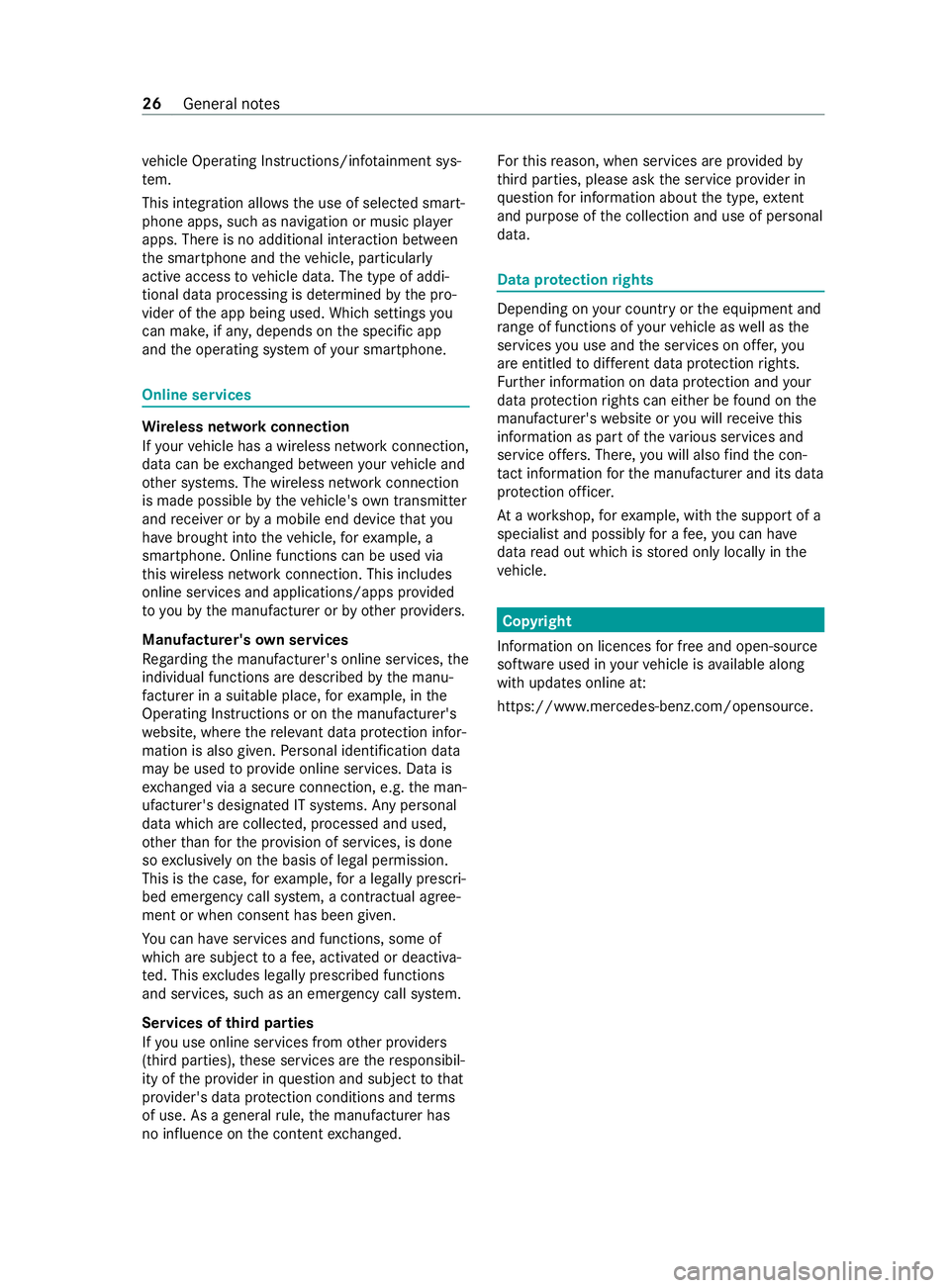
ve
hicle Operating Instructions/info tainment sys‐
te m.
This integration allow sth e use of selected smart‐
phone apps, such as navigation or music pla yer
apps. There is no additional interaction between
th e smartphone and theve hicle, particularly
active access tovehicle data. The type of addi‐
tional data processing is de term ined bythe pro‐
vider of the app being used. Which settings you
can make, if an y,depends on the specific app
and the operating sy stem of your smartphone. Online services
Wire
less network connection
If yo ur vehicle has a wireless network connection,
data can be exchanged between your vehicle and
ot her sy stems. The wireless network connection
is made possible bytheve hicle's own transmitter
and receiver or bya mobile end device that you
ha ve brought into theve hicle, forex ample, a
smartphone. Online functions can be used via
th is wireless network connection. This includes
online services and applications/apps pr ovided
to yo uby the manufacturer or by other pr oviders.
Manu factu rer's own services
Re garding the manufacturer's online services, the
individual functions are described bythe manu‐
fa cturer in a sui table place, forex ample, in the
Operating Instructions or on the manufacturer's
we bsite, where there leva nt da taprotection infor‐
mation is also given. Personal identification data
may be used toprov ide online services. Data is
exc hanged via a secure connection, e.g. the man‐
ufacturer's designated IT sy stems. Any personal
data which are collected, processed and used,
ot her than forth e pr ovision of services, is done
so exc lusively on the basis of legal permission.
This is the case, forex ample, for a legally prescri‐
bed emergency call sy stem, a cont ractual agree‐
ment or when consent has been given.
Yo u can ha veservices and functions, some of
which are subject toafe e, activated or deactiva‐
te d. This excludes legally prescribed functions
and services, such as an emer gency call sy stem.
Services of third parties
If yo u use online services from other pr oviders
(third parties), these services are there sponsibil‐
ity of the pr ovider in question and subject tothat
pr ov ider's data pr otection conditions and terms
of use. As a general rule, the manufacturer has
no influence on the content exchanged. Fo
rth is reason, when services are pr ovided by
th ird parties, please ask the service pr ovider in
qu estion for information about the type, extent
and pu rpose of the collection and use of personal
data. Data pr
otection rights Depending on
your country or the equipment and
ra nge of functions of your vehicle as well as the
services you use and the services on of fer, you
are entitled todiffere nt da taprotection rights.
Fu rther information on data pr otection and your
data pr otection rights can either be found on the
manufacturer's website or you will receive this
information as part of theva rious services and
service of fers . The re,yo u will also find the con‐
ta ct information forth e manufacturer and its data
pr otection of ficer.
At awo rkshop, forex ample, with the support of a
specialist and possibly for a fee, you can ha ve
data read out which is stored only locally in the
ve hicle. Copyright
Information on licences for free and open-sou rce
software used in your vehicle is available along
with updates online at:
https://www.mercedes-benz.com/opensource. 26
General no tes
Page 40 of 337
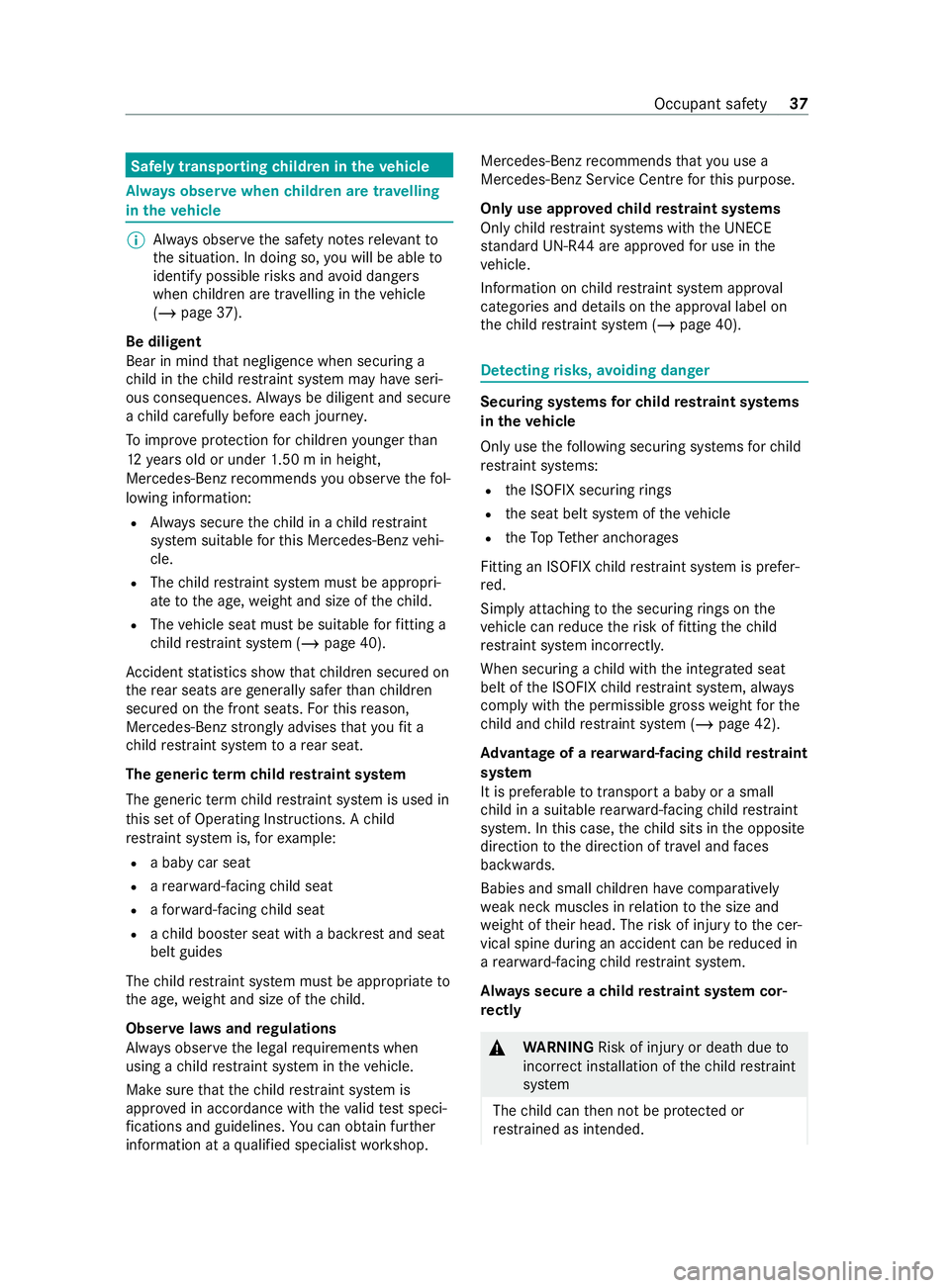
Safely transporting
children in theve hicle Alw
ays obser vewhen children are tr avelling
in theve hicle %
Alw
ays obser vethe saf ety no tesre leva nt to
th e situation. In doing so, you will be able to
identify possible risks and avoid dangers
when children are tra velling in theve hicle
(/ page 37).
Be diligent
Bear in mind that negligence when securing a
ch ild in thech ild restra int sy stem may ha veseri‐
ous consequences. Alw ays be diligent and secure
a ch ild carefully before each journe y.
To impr ove pr otection forch ildren younger than
12 years old or under 1.50 m in height,
Mercedes-Benz recommends you obse rveth efo l‐
lowing information:
R Always secure thech ild in a child restra int
sy stem suitable forth is Mercedes-Benz vehi‐
cle.
R The child restra int sy stem must be appropri‐
ate tothe age, weight and size of thech ild.
R The vehicle seat must be suitable forfitting a
ch ild restra int sy stem (/ page 40).
Ac cident statistics show that children secured on
th ere ar seats are general lysafer than children
secured on the front seats. Forth is reason,
Mercedes-Benz strongly advises that youfit a
ch ild restra int sy stem toare ar seat.
The generic term ch ildrestra int sy stem
The generic term child restra int sy stem is used in
th is set of Operating Instructions. A child
re stra int sy stem is, forex ample:
R a baby car seat
R are ar wa rd-facing child seat
R afo rw ard-facing child seat
R ach ild boos ter seat with a backrest and seat
belt guides
The child restra int sy stem must be appropriate to
th e age, weight and size of thech ild.
Obser velaws and regulations
Alw ays obser vethe legal requirements when
using a child restra int sy stem in theve hicle.
Make sure that thech ild restra int sy stem is
appr oved in accordance with theva lid test speci‐
fi cations and guidelines. You can obtain fur ther
information at a qualified specialist workshop. Mercedes-Benz
recommends that you use a
Mercedes-Benz Service Cent reforth is purpose.
Only use app rove dch ild restra int sy stems
Only child restra int sy stems with the UNECE
st andard UN-R44 are appr oved for use in the
ve hicle.
Information on child restra int sy stem appr oval
categories and de tails on the appr oval label on
th ech ild restra int sy stem (/ page 40). De
tecting risks, avoiding danger Securing sy
stems forch ild restra int sy stems
in theve hicle
Only use thefo llowing securing sy stems forch ild
re stra int sy stems:
R the ISOFIX securing rings
R the seat belt sy stem of theve hicle
R theTo pTe ther anchorages
Fitting an ISOFIX child restra int sy stem is prefer‐
re d.
Simply attaching tothe securing rings on the
ve hicle can reduce therisk of fitting thech ild
re stra int sy stem incor rectl y.
When securing a child with the integrated seat
belt of the ISOFIX child restra int sy stem, alw ays
comply wi th the permissible gross weight forthe
ch ild and child restra int sy stem (/ page 42).
Ad vantage of a rear wa rd-facing child restra int
sy stem
It is preferable totranspo rta baby or a small
ch ild in a suitable rear wa rd-facing child restra int
sy stem. In this case, thech ild sits in the opposite
direction tothe direction of tra vel and faces
ba ckwa rds.
Ba bies and small children ha vecompa ratively
we ak neck muscles in relation tothe size and
we ight of their head. The risk of injury tothe cer‐
vical spine during an accident can be reduced in
a re ar wa rd-facing child restra int sy stem.
Alw ays secure a child restra int sy stem cor‐
re ctly &
WARNING Risk of injury or death dueto
incor rect ins tallation of thech ild restra int
sy stem
The child can then not be pr otected or
re stra ined as intended. Occupant saf
ety37
Page 42 of 337
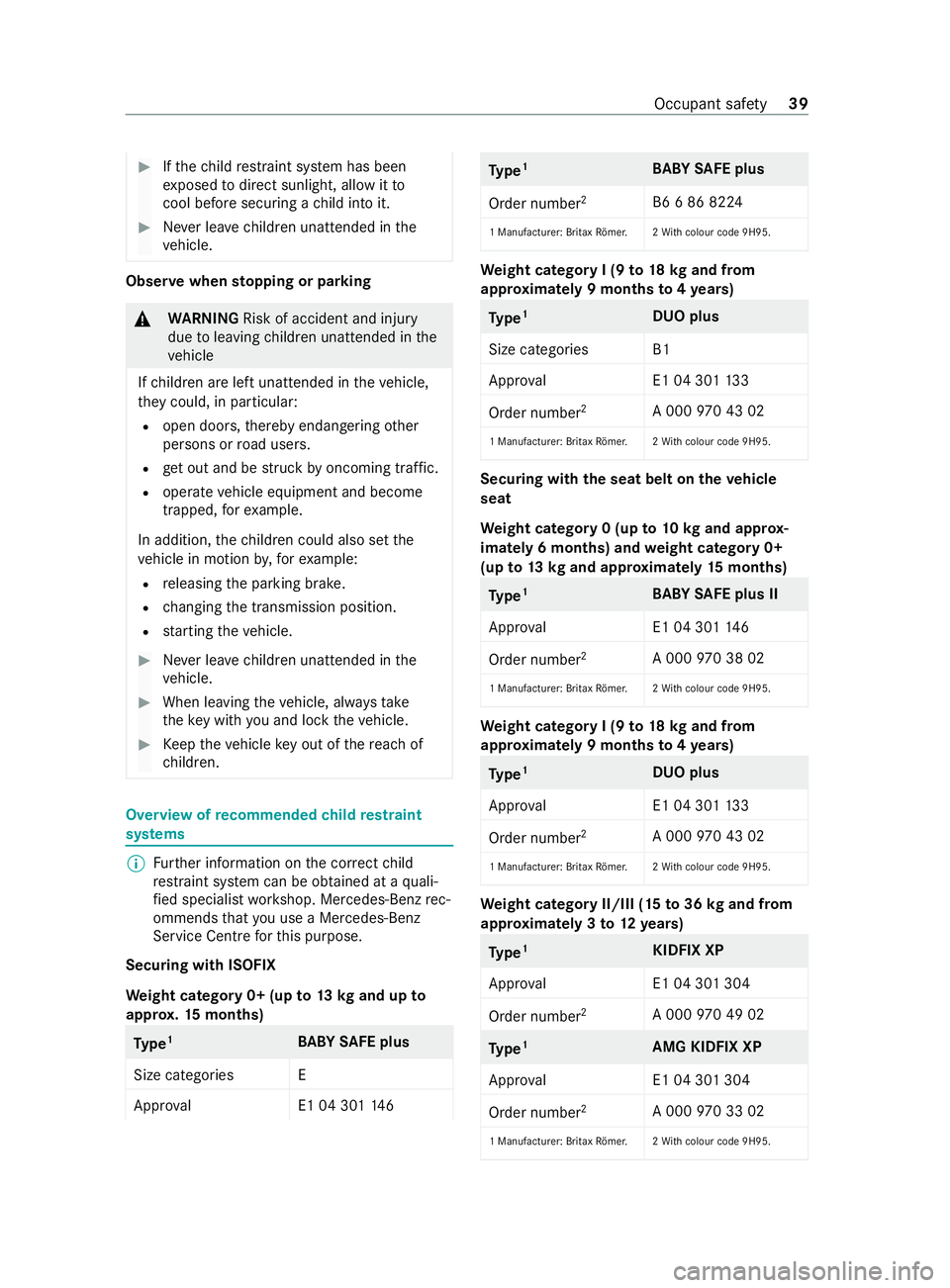
#
Ifth ech ild restra int sy stem has been
ex posed todirect sunlight, allow it to
cool before secu ring a child into it. #
Never lea vechildren unat tended in the
ve hicle. Obser
vewhen stopping or parking &
WARNING Risk of accident and inju ry
due toleaving children unat tended in the
ve hicle
If ch ildren are left unat tended in theve hicle,
th ey could, in part icular:
R open doors, thereby endangering other
persons or road users.
R get out and be stru ck byoncoming traf fic.
R operate vehicle equipment and become
trapped, forex ample.
In addition, thech ildren could also set the
ve hicle in motion by,fo rex ample:
R releasing the parking brake.
R changing the transmission position.
R starting theve hicle. #
Never lea vechildren unat tended in the
ve hicle. #
When leaving theve hicle, alw aysta ke
th eke y with you and lock theve hicle. #
Keep theve hicle key out of there ach of
ch ildren. Overview of
recommended child restra int
sy stems %
Fu
rther information on the cor rect child
re stra int sy stem can be obtained at a quali‐
fi ed specialist workshop. Mercedes-Benz rec‐
ommends that you use a Mercedes-Benz
Service Cent reforth is purpose.
Securing with ISOFIX
We ight category 0+ (up to13 kgand up to
appr ox.15 months) Ty
pe 1
BABY SAFE plus
Size categories E
App rova lE 1 04 30114 6 Ty
pe 1
BABY SAFE plus
Order number 2
B6 6 86 82 24
1 Manufacturer: Britax Römer .2 With colour code 9H95. We
ight category I (9 to18 kgand from
appr oxima tely 9 months to4ye ars) Ty
pe 1
DUO plus
Size catego ries B1
Appr oval E1 04 30113 3
Order number 2
A 000970 43 02
1 Manufacturer: Britax Römer .2 With colour code 9H95. Securing with th
e seat belt ontheve hicle
seat
We ight category 0 (up to10 kgand appr ox‐
ima tely 6 months) and weight category 0+
(up to13 kgand appr oxima tely 15 months) Ty
pe 1
BABY SAFE plus II
App rova lE 1 04 30114 6
Order number 2
A 000970 38 02
1 Manufacturer: Britax Römer .2 With colour code 9H95. We
ight category I (9 to18 kgand from
appr oxima tely 9 months to4ye ars) Ty
pe 1
DUO plus
Appr oval E1 04 30113 3
Order number 2
A 000970 43 02
1 Manufacturer: Britax Römer .2 With colour code 9H95. We
ight category II/III (15 to36 kgand from
appr oxima tely 3to 12 years) Ty
pe 1
KIDFIX XP
Appr oval E1 04 301 304
Order number 2
A 000970 49 02 Ty
pe 1
AMG KIDFIX XP
Appr oval E1 04 301 304
Order number 2
A 000970 33 02
1 Manufacturer: Britax Römer .2 With colour code 9H95. Occupant saf
ety39
Page 61 of 337

#
Press and hold the sliding door button until
th e sliding door has opened or closed.
The sliding door mo ves with increased forc e.
Obser vethat in such circum stances, the
bloc kage detection is less sensitive. Tostop
th e mo vement, release the sliding door but‐
to n. #
Remo vethe cause of the bloc kage atthe ear‐
liest opportunity. Ta
ilgate Opening and closing
the tailgate &
DANG ER Risk of exhaust gas poisoning
Combustion engines emit poisonous exhaust
ga ses such as carbon monoxide. Exhaust
ga ses can enter theve hicle interior if theta il‐
gate is open when the engine is running,
especially if theve hicle is in motion. #
Always switch off the engine before
opening theta ilgate. #
Never drive with theta ilgate open. *
NO
TEDama getotheta ilgate caused by
obs tacles ab ovetheve hicle The
tailgate swings rear wa rds and upwards
when it is opened. #
Make sure that there is suf ficient space
behind and ab ovetheta ilgate. %
Yo
u will find de tails of theta ilgate opening
dimensions under "Technical data"
(/ page 276). #
Toopen: push button 1onthe handle and
ra ise theta ilgate. #
Toclose: pulltheta ilgate firm ly down wards
by loop 2and close it from outside.
Opening the tailgate in an emer gency
If th e battery voltage is low or thevo ltage supply
is inter rupte d,theta ilgate cannot be opened.
In an emer gency, you can open theta ilgate using
th ere lease cat chfor service purposes. #
Prise off the co ver on the lo wer part of the
ta ilgate with a suitable tool, e.g. the scr ew‐
driver from theve hicle tool kit. #
Insert the scr ewdriver into the opening and
mo vethere lease le ver until theta ilgate
unloc ksand opens. #
Lift theta ilgate upwards. EAS
Y-PA CK tailgate Note
s onthe EAS Y-PA CK tailgate &
DANG ER Risk of exhaust gas poisoning
Combustion engines emit poisonous exhaust
ga ses such as carbon monoxide. Exhaust
ga ses can enter theve hicle interior if theta il‐
gate is open when the engine is running,
especially if theve hicle is in motion. #
Always switch off the engine before
opening theta ilgate. #
Never drive with theta ilgate open. *
NO
TEDama getotheta ilgate caused by
obs tacles ab ovetheve hicle The
tailgate swings rear wa rds and upwards
when it is opened. #
Make sure that there is suf ficient space
behind and ab ovetheta ilgate. %
Yo
u will find de tails of theta ilgate opening
dimensions under "Technical data"
(/ page 276). 58
Opening and closing
Page 107 of 337

#
Insert the plug of the device into 230 V
soc ket3.
When the on-board electrical sy stem voltage
is suf ficient, indicator la mp1lights up.
When you are not using the 230 V po wer soc ket,
ke ep theflap closed. Swit
ching there frigerator box in the centre
console on and off &
WARNING Risk offire due toa co vered
ve ntilation grille on the coolbox
If yo u co verth eve ntilation grille forth e cool‐
box, it may overheat. #
Always make sure that theve ntilation
grille is not co vered. The coolbox
ventilation grille is between the front
seat base and the cent reconsole sid ewall.
Re quirements
R The ignition is switched on.
R The stow age compartment under the armrest
is open (/ page 96). The
refrigerator box can bear a maximum load of
3.5 kg. #
Toopen: fold co ver1 upwards. #
Toswitch the cooling le velto low: press
button 2for appro ximately two seconds. #
Toswitch the cooling le velto high: press
button 2again. #
Toswitch off: press button 2for appro x‐
ima tely two seconds until all indica tor lamps
go out. %
If
yo u do not need touse there frigerator box
fo r an extended pe riod, you should swit chit
off, defrost it and clean it. Af ter doing so,
lea vethe cap open for a time. Note
s on attaching the iPad ® Yo
ur vehicle is equipped with iPad ®
attachment
1 onthe driver's and co-driver's seat backrests.
A mount, which has been tested and appr oved
especially for Mercedes-Benz vehicles, is availa‐
ble as an accesso ry. Only this mount can unlock
th e attachment opening and allow the iPad ®
to
be charge d whilst it is ins talled.
iPad ®
attachment 1may only be used for
accesso ries up to42 W (3.5 A).
Contact a Mercedes-Benz Service Centre for
information and availabilit y.Before using the
mount, please read the operating instructions for
th e mount.
% Only use accessories which ha
vebeen tested
and recommended byMercedes-Benz. 104
Seats and stowage
Page 114 of 337
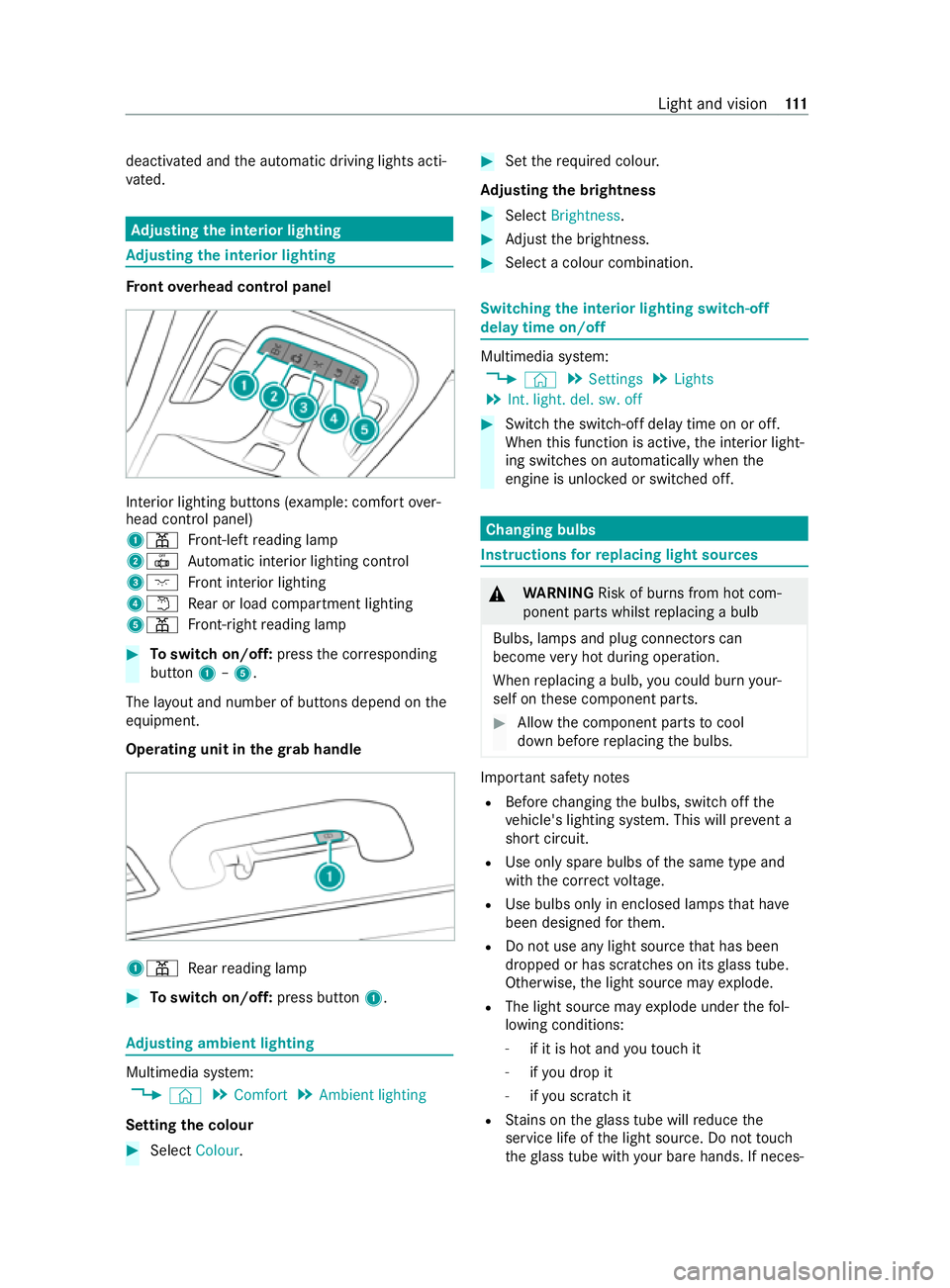
deactivated and
the automatic driving lights acti‐
va ted. Ad
justing the in terior lighting Ad
justing the in terior lighting Fr
ont overhead control panel In
te rior lighting buttons (e xample: com fort ove r‐
head control panel)
1003D Front-left reading lamp
20033 Automatic interior lighting control
3004A Front interior lighting
40044 Rear or load compartment lighting
5003D Front-ri ghtreading lamp #
Toswitch on/off: pressthe cor responding
button 1–5.
The la yout and number of buttons depend on the
equipment.
Operating unit in thegr ab handle 1003D
Rear reading lamp #
Toswitch on/off: press button1. Ad
justing ambient lighting Multimedia sy
stem:
4 © 5
Comfort 5
Ambient lighting
Setting the colour #
Select Colour. #
Set therequ ired colour.
Ad justing the brightness #
Select Brightness . #
Adjust the brightness. #
Select a colour combination. Switching
the interior lighting switch-off
delay time on/off Multimedia sy
stem:
4 © 5
Settings 5
Lights
5 Int. light. del. sw. off #
Switch the switch-off delay time on or off.
When this function is active, the interior light‐
ing switches on automatically when the
engine is unloc ked or switched off. Changing bulbs
Instructions
forre placing light sou rces &
WARNING Risk of burn s from hot com‐
ponent parts whilst replacing a bulb
Bulbs, lamps and plug connectors can
become very hot during operation.
When replacing a bulb, you could burn your‐
self on these component parts. #
Allow the component parts tocool
down before replacing the bulbs. Impor
tant sa fety no tes
R Before changing the bulbs, switch off the
ve hicle's lighting sy stem. This will pr event a
sho rtcircuit.
R Use only spa rebulbs of the same type and
with the cor rect voltage.
R Use bulbs only in enclosed lamps that ha ve
been designed forth em.
R Do not use any light source that has been
dropped or has scratches on its glass tube.
Otherwise, the light source may explode.
R The light source may explode under thefo l‐
lowing conditions:
- if it is hot and youto uch it
- ifyo u drop it
- ifyo u sc ratch it
R Stains on theglass tube will reduce the
service life of the light source. Do not touch
th eglass tube with your bare hands. If neces‐ Light and vision
111
Page 141 of 337

#
Avoid high engine speeds and driving at
full thro ttle until the engine has reached
its operating temp erature. Note
s on short-distance trips
If th eve hicle is predominantly used in short-dis‐
ta nce driving, a fault in the automatic cleaning
function of the diesel particulate filter can occur.
Due tothis, fuel may also accumulate in the
engine oil and cause engine failure.
During automatic cleaning, extreme lyhot exhaust
ga ses escape from theex haust pipe. Maintain a
dis tance of at least 1 m to other objects, e.g.
par kedve hicles, in order toavoid material dam‐
age.
If yo u main lydrive short dis tances, you should
drive on a mo torw ay or go for a country drive for
20 minutes every500 km. This facilitates the
re ge neration of the diesel particulate filter.
Information about driving abroad
Service
An extensive Mercedes-Benz service is also avail‐
able abroad. Ne vertheless, please remember that
services or spare parts may not be available
immediatel y.The releva nt wo rkshop directories
are available from a Mercedes-Benz Service
Cent re.
Fu el
In some countries, only fuels with an inc reased
sulphur con tent are available.
Uns uitable fuel can cause engine damage. Yo u
can find fur ther information under "Fuel"
(/ page 270).
Ad Blue ®
Ad Blue ®
is not available in suf ficient quality in all
countries. Therefore, check theAd Blue ®
leve l,
particular lybefore driving outside Europe
(/ page 148). Consul t aqualified specialist
wo rkshop for advice.
Yo u can find information about AdBlue ®
in "Oper‐
ating fluids and capacities" (/ page271).
Low beam
In countries in whi chtraf fic drives on the oppo‐
site side of thero ad from the count ryin which
th eve hicle is regis tere d, you will ha vetoswitch
th e headlamps tosymmetrical dipped beam. This
will pr event oncoming traf fic from being dazzled.
Symm etrical dipped beam will no longer illumi‐
nate the edge of the car riag ewa y as far or as
high. Ve
hicles with halogen headlamps:
It is not necessa ryto change the headlamps over
to symmetrical dipped beam. The statutory
requ irements of the count ries in which tra ffic
drives on the opposite side of thero ad from the
country in whi ch theve hicle is regis tere d are also
met without changing over.
Ve hicles with LED headlamps:
Yo u can set the low beam for driving on theright
or left via the on-board computer (/ page189).
Information about transport byrail
Tr ansporting your vehicle byrail may be subject
to cer tain restrictions or requ ire special meas‐
ures tobe take n in some countries due tovarying
tunnel heights and loading standards.
Yo u can obtain information about this from a
Mercedes-Benz Service Cent re.
Information on brakes &
WARNING Risk of accident due tothe
brake sy stem overheating
If yo u lea veyour foot on the brake pedal
when driving, the brake sy stem may overheat.
This increases the braking dis tance and the
brake sy stem may evenfa il. #
Never use the brake pedal as a foot re st. #
Do not depress the brake pedal and the
accelerator pedal at the same time
while driving. *
NO
TECausing wearto the brake linings
by permanently depressing the brake
pedal #
Do not permanently depress the brake
pedal while driving. #
Touse braking ef fect of the engine, shift
to a lo werge ar in good time. Downhill
gradients
On long and steep downhill gradients you should
obse rveth efo llowing instructions:
R invehicles with an automatic transmission,
shift down toshift ranges 2or 1in good time
so that the engine is running at a medium to
high engine speed (/ page143).
R invehicles with a manual transmission, shift
down toa lo werge ar in good time, so that the
engine is running at a medium tohigh engine
speed. 13 8
Driving and pa rking
Page 142 of 337
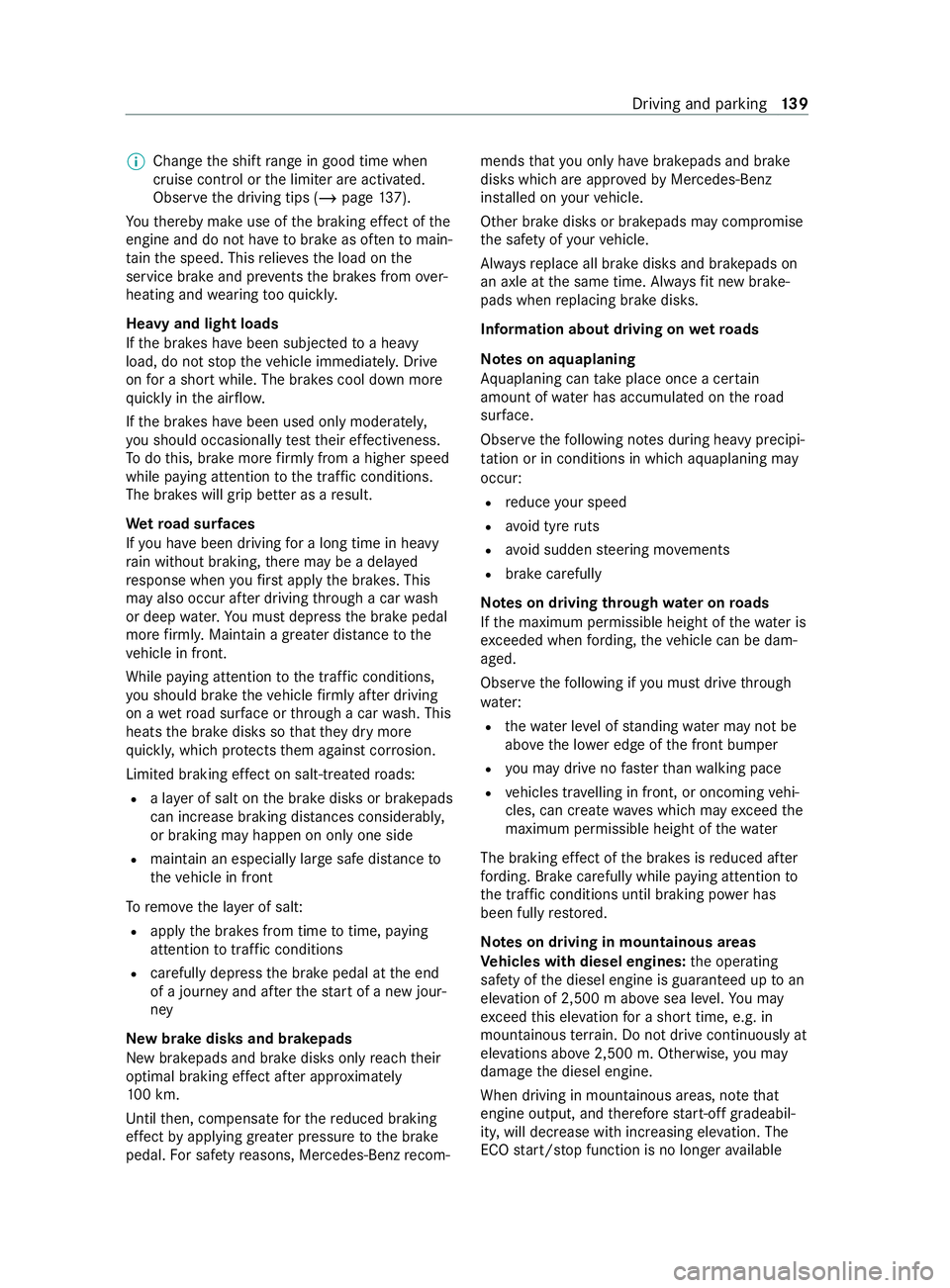
%
Chan
gethe shift range in good time when
cruise control or the limiter are activated.
Obser vethe driving tips (/ page137).
Yo uth ereby make use of the braking ef fect of the
engine and do not ha vetobrake as of tento main‐
tai nth e speed. This relie vesth e load on the
service brake and pr events the brakes from over‐
heating and wearing tooqu ickl y.
Heavy and light loads
If th e brakes ha vebeen subjected toa heavy
load, do not stop theve hicle immediatel y.Drive
on for a short while. The brakes cool down more
qu ickly in the air flow.
If th e brakes ha vebeen used only moderately,
yo u should occasionally test their ef fectiveness.
To do this, brake more firm ly from a higher speed
while pa ying attention tothe traf fic conditions.
The brakes will grip better as a result.
We tro ad sur faces
If yo u ha vebeen driving for a long time in heavy
ra in without braking, there may be a dela yed
re sponse when youfirs t apply the brakes. This
may also occur af ter driving thro ugh a car wash
or deep water.Yo u must depress the brake pedal
more firm ly. Maintain a grea ter dis tance tothe
ve hicle in front.
While paying attention tothe traf fic conditions,
yo u should brake theve hicle firm lyafte r driving
on a wetro ad sur face or thro ugh a car wash. This
heats the brake disks so that they dry more
qu ickl y,which pr otects them against cor rosion.
Limited braking ef fect on salt-treate dro ads:
R a layer of salt on the brake disks or brakepads
can increase braking dis tances considerably,
or braking may happen on only one side
R maintain an especially large safe dis tance to
th eve hicle in front
To remo vethe la yer of salt:
R apply the brakes from time totime, paying
attention totraf fic conditions
R carefully dep ress the brake pedal at the end
of a journey and af terth est art of a new jour‐
ney
Ne w brake dis ksand brakepads
New brakepads and brake disks only reach their
optimal braking ef fect af ter appro ximately
10 0 km.
Un tilthen, compensate forth ere duced braking
ef fect by applying greater pressure tothe brake
pedal. For saf etyre asons, Mercedes-Benz recom‐ mends
that you on lyha ve brakepads and brake
disks which are appr ovedby Mercedes-Benz
ins talled on your vehicle.
Other brake disks or brakepads may compromise
th e saf ety of your vehicle.
Alw aysre place all brake disks and brakepads on
an axle at the same time. Alw aysfit new brake‐
pads when replacing brake disks.
Information about driving on wetro ads
Note s on aquaplaning
Aq uaplaning can take place once a cer tain
am ount of water has accumulated on thero ad
sur face.
Obser vethefo llowing no tes during heavy precipi‐
ta tion or in conditions in which aquaplaning may
occu r:
R reduce your speed
R avoid tyre ruts
R avoid sudden steering mo vements
R brake carefully
Note s on driving through water on roads
If th e maximum permissible height of thewate r is
exc eeded when ford ing, theve hicle can be dam‐
aged.
Obser vethefo llowing if you must drive thro ugh
wate r:
R thewate r level of standing water may not be
abo vethe lo wer edge of the front bumper
R you may drive no fasterthan walking pace
R vehicles tr avelling in front, or oncoming vehi‐
cles, can create waves which may exceed the
maximum permissible height of thewa ter
The braking ef fect of the brakes is reduced af ter
fo rd ing. Brake carefully while paying attention to
th e traf fic conditions until braking po wer has
been fully restored.
Note s on driving in mountainous areas
Ve hicles with diesel engines: the operating
saf ety of the diesel engine is guaranteed up toan
ele vation of 2,500 m ab ovesea le vel.Yo u may
exc eed this ele vation for a short time, e.g. in
mountainous terrain. Do not drive continuously at
ele vations ab ove2,500 m. Otherwise, you may
damage the diesel engine.
When driving in mountainous areas, no tethat
engine output, and therefore start-off gradeabil‐
ity, will dec rease with inc reasing ele vation. The
ECO start/ stop function is no longer available Driving and parking
13 9
Page 151 of 337

R
The ignition is switched off.
R The front left-hand door is open.
% Do not
get ba ckinto theve hicle during the
re fuelling process. Otherwise, electros tatic
ch arge could build up again.
Obser vethe no tes on operating fluids
(/ page 269). #
Open fuel filler flap 1. #
Turn fuel filler cap 2anti-clockwise and
re mo veit. #
Close all vehicle doors topreve nt fuel
va pours from entering theve hicle interior. #
Comple tely slide thefiller neck of the pump
nozzle into theta nk, hook in place and refuel. #
Fillthe fuel tank only until the pump nozzle
switches off. #
Replace fuel filler cap 2and turn it clock‐
wise.
Yo u will hear a click when the fuel filler cap is
closed full y. #
Open the front left-hand door. #
Close fuel filler flap 1.
% Ve
hicles with a diesel engine and incor‐
re ct fuelling pr otector against refuelling
with petrol: thefiller neck is designed for
re fuelling at diesel filling pumps for
passenger vehicles.
% Ve
hicles with a diesel engine without an
incor rect fuelling pr otector: refuelling pre‐
fe rred at diesel filling pumps for passenger
ve hicles. Ho wever,yo u can also refuel at a
diesel filling pump for lor ries.
% If
th e fuel tank has been run comple tely dr y,
to p up with at least 5 l of fuel. Before starting th
e engine again: switch on the ignition three
or four times.
% Ve
hicles that can use a mixture of fuels can
be recognised bythest icke r "Ethanol up to
E85!" on the fuel filler flap. Ad
Blue ® Note
s onAdBlue ®
Ad Blue ®
is a wate r-soluble fluid forth eex haust
ga s af tertre atment of diesel engines. In order for
th eex haust gas af tertre atment tofunction prop‐
er ly, only use AdBlue ®
in accordance with
ISO 222 41 .
Ad Blue ®
has thefo llowing properties:
R non-t oxic
R colourless and odourless
R non-flammable
If yo u open theAd Blue ®
tank, small amounts of
ammonia vapour may be released. Fill the
Ad Blue ®
tank only in well-ventilated areas.
Do not let AdBlue ®
come into contact wi thskin,
ey es or clo thes. Keep AdBlue ®
aw ay from chil‐
dren.
Do not ingest AdBlue ®
. If AdBlue ®
is swallo wed,
immediately rinse your mouth out thoroughly.
Drink plenty of water.Seek medical attention at
once.
Obser vethe no tes on the operating fluid AdBlue ®
(/ page 272).
Ad Blue ®
av ailability:
R AdBlue ®
can be topped up at a qualified spe‐
cialist workshop, e.g. a Mercedes-Benz
Service Centre.
R AdBlue ®
is available at numerous filling sta‐
tions via AdBlue ®
filling pumps.
R Alternatively, AdBlue ®
is available at qualified
specialist workshops, e.g. a Mercedes-Benz
Service Centre, and at numerous filling sta‐
tions as an AdBlue ®
re fill canis ter or AdBlue ®
re fill bottle.
% Ensure
the connection between there fill con‐
ta iner and vehicle filler neck does not drip. 14 8
Driving and pa rking